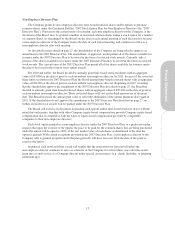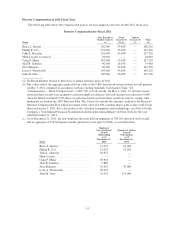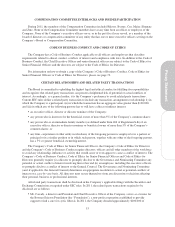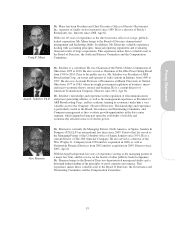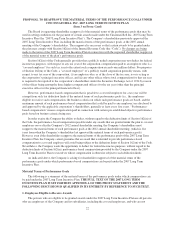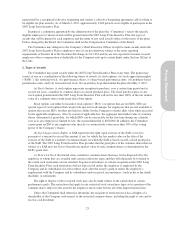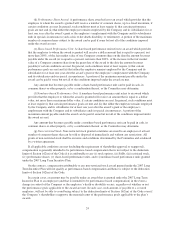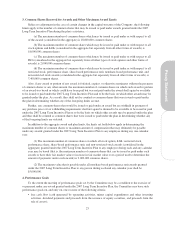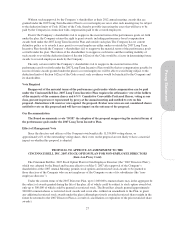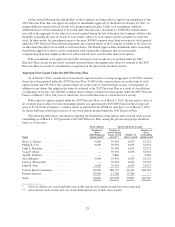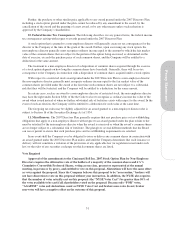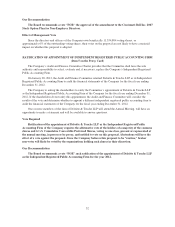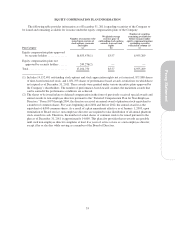Cincinnati Bell 2011 Annual Report Download - page 37
Download and view the complete annual report
Please find page 37 of the 2011 Cincinnati Bell annual report below. You can navigate through the pages in the report by either clicking on the pages listed below, or by using the keyword search tool below to find specific information within the annual report.
represented by a recognized collective bargaining unit (unless a collective bargaining agreement calls for them to
be eligible for plan awards). As of March 2, 2012, approximately 2,200 persons were eligible to participate in the
2007 Long Term Incentive Plan.
In general, a committee appointed by the administrator of the plan (the “Committee”) selects the specific
eligible employees to whom awards will be granted under the 2007 Long Term Incentive Plan, the types of
awards that will be granted to each employee and the terms of any such award (subject to the terms of the plan).
Unless changed by the Board, the Committee shall be the Compensation Committee of the Board.
The Committee may delegate to the Company’s Chief Executive Officer its right to make awards under the
2007 Long Term Incentive Plan to employees who (i) are not otherwise subject to the stock reporting
requirements of Section 16 of the Securities Exchange Act of 1934 and (ii) are not expected to become covered
employees whose compensation is deductible by the Company only up to certain limits under Section 162(m) of
the Code.
2. Types of Awards
The Committee may grant awards under the 2007 Long Term Incentive Plan at any time. The grants may
consist of one or a combination of the following forms of awards: (i) stock options, (ii) stock appreciation rights
(“SARs”), (iii) restricted stock, (iv) performance shares, (v) share-based performance units, (vi) nonshare-based
performance units, and (vii) non-restricted stock. No award may be granted under the plan after May 2, 2017.
(a) Stock Options. A stock option represents an option to purchase, over a certain time period not to
exceed ten years, a number of common shares at a fixed purchase price. The fixed purchase price of any
stock option granted under the 2007 Long Term Incentive Plan will not be less than 100% of the fair market
value of a common share on the grant date of the option.
Stock options can either be incentive stock options (“ISOs”) or options that are not ISOs. ISOs are
special types of stock options that can provide special tax advantages for employees that are not available to
options that are not ISOs, but they provide less ability for the Company to deduct their value when exercised
by the applicable employees. Also, by reason of applicable law, the aggregate fair market value of common
shares, determined at grant date, for which ISOs can be exercisable for the first time during any calendar
year as to any employee is limited by law; the current limitation is $100,000. In addition, the Committee
cannot grant an ISO to any employee who directly or constructively owns more than 10% of the voting
power of the Company’s shares.
(b) Stock Appreciation Rights. A SAR represents the right, upon exercise of the SAR, to receive
payment of a sum not to exceed the amount, if any, by which the fair market value on the date of the
exercise of the SAR of a number of common shares on which the SAR is based exceeds a fixed grant price
of the SAR. The 2007 Long Term Incentive Plan provides that the grant price of the common shares that are
subject to a SAR may not be less than the fair market value of such common shares as determined on the
SAR’s grant date.
(c) Restricted Stock. Restricted stock constitutes common shares that may not be disposed of by the
employee to whom they are awarded until certain restrictions lapse and that will ultimately be forfeited to
the extent such restrictions are not satisfied. In general and subject to certain exceptions in the 2007 Long
Term Incentive Plan, such restrictions will not lapse in full unless the employee is employed by the
Company and its subsidiaries for at least three years after the award’s grant or unless the employee’s
employment with the Company and its subsidiaries ends in special circumstances, (such as his or her death,
disability, or retirement).
The right to dispose of the restricted stock may also be made subject to the satisfaction of certain
performance goals. The restrictions that apply to any restricted stock award may lapse as to a portion of the
common shares subject to the award if the employee meets some but not all of the imposed restrictions.
Unless the Committee shall otherwise determine, the recipient of restricted stock has all rights of a
shareholder of the Company with respect to the restricted common shares, including the right to vote and to
receive cash dividends.
23
Proxy Statement


